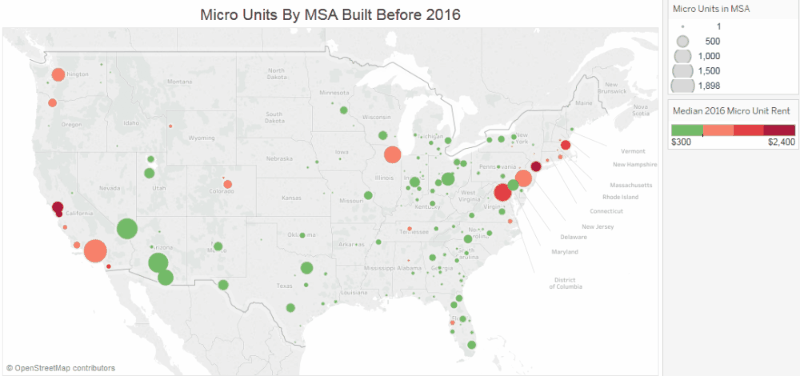Visualization: Microhousing in the United States
In an recent article, RCLCO (formerly Robert Charles Lesser & Co.), presented an interesting visualization of microhousing in the United States, “Is Smaller Getting Bigger? Visualizing Micro Units Across the United States.” While it is interesting to put our own microhousing question in national perspective there a couple of really important notes before going all in on this analysis. First, this visualization is based purely unit size, here the definition is 350 square feet, much bigger than what we would consider microhousing in Seattle. From the article:
Although the real estate industry has recently focused on the perceived shift toward these small micro units, the majority of micro units renting today were built over several decades and are simply small units in conventional apartment buildings.
I would suggest that when we think of microhousing in Seattle, we’re talking about more than simply the size of the units. We’re also talking about shared use kitchens and common spaces. Furthermore, our microhousing developed out of an institutional framework of supportive housing used mostly by non-profits. Recovery, transitional, or half-way houses often use multiple rooms with shared bathrooms, kitchens, and common spaces. What our local builders figured out was a way to bring that model to the market. It wasn’t simply smaller units.
Second, you’ll notice that many of the areas on the map are college towns.
The metro areas with the highest percentage of micro units are small markets with universities that support institutional rental apartments primarily through students who are willing to live in very small units.
Again, not exactly what we talk about when we talk about micros in Seattle. It is true, and I’d be willing to bet, that the vast majority of tenants of congregate microhousing are between the ages of 18 and 30 and are either in school, have lived in a dorm, or have lived or considered living in a shared housing situation. I was sort of surprised to see the Twin Cities with so many because in my own visit there locals said size limits of 400 square feet made the kind of microhousing impossible. The little bubble next to the Twin Cities, St. Cloud, Minnesota, had a bunch too. No surprise since St. Cloud is a university town, with over 16,000 students attending just Saint Cloud State University.
Third, this analysis is by real estate people for real estate people. Some of the language, to a lay person, will sound cynical. It’s not. But let me cite the paragraph I’m thinking of:
The steep premiums in these markets indicate that developers may be able to drive up per-square-foot rents by delivering more and smaller studios in conventional apartment communities across the nation. This is consistent with research recently published in an RCLCO Advisory, which found that the average size of a new apartment built since 2010 is 70 square feet smaller than the average size for units built from 2000 to 2009.
I hate that phrase “developers may be able to drive up per-square-foot rents.” I really, really hate it. Developers don’t “drive up rents,” market dynamics set rents. Always. But what the paragraph is getting at is that from an investor perspective microhousing can be a good vehicle for creating returns. Keep in mind that real estate investors tend to measure things on a per-square-foot basis. That’s how they think and that’s how they look at investments. Their point is that if you’re looking for a good investment in hot markets, smaller units create better returns per-square-foot. That makes perfect sense since the rents in hot markets are going to be higher than other places, and a smaller unit will be competitive on a per-square-foot basis with a larger product.
From the renter perspective, I’ve dealt with this per-square-foot issue before. I’ve been hassled that I pay too much per-square-foot for my micro unit. The response is obvious: math and utility. Sure, I pay twice as much for my 200 plus square foot unit as I would for a three times as much apartment in West Seattle or Kent; but I don’t want to live in West Seattle or Kent in a 600 square foot apartment. The per-square-foot criticism is like criticizing me because I pay too much for Diet Coke because I pay more per ounce when I buy it by the can than if I bought a case at Costco. It’s true, but I don’t want a case of Diet Coke and I don’t want to store it. I choose to live in a smaller space closer to the things I want to be closer to an pay less over all than I would in a larger apartment in the same place.
Lastly, I guess because today we’re battling for inches in feet in the small apartment options we do have left, the article isn’t about what David Neiman has pointed out in Seattle: there’s a regulatory effort to push up the size of smaller apartments in Seattle so that they are no longer small apartments but just plain old studios. I would have changed the headline, since what RLCO means by “bigger” is a play on words to talk about the popularity of micros rather than their relative per-unit size. Just a minor editorial note, but I kept expecting to see an exposition of how the size of smaller units was creeping upward. No, the point was that they are becoming more popular. All in all, a great set of visuals worth checking out.


